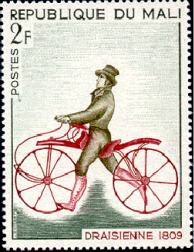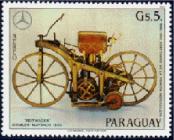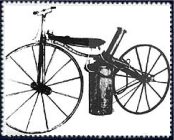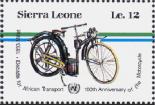The first motorcycle? |
|
|
|
|
"Who invented the first motorcycle?" It
seems like a simple question, but the answer is a bit complicated.
|
|
Motorcycles are descended from the
"safety" bicycle, bicycles with front and rear wheels of
the same size, with a pedal crank mechanism to drive the rear wheel.
Those bicycles, in turn were descended from high-wheel bicycles. The
high-wheelers were descended from an early type of push-bike,
without pedals, propelled by the rider's feet pushing against the
ground. These appeared around 1800, used iron-banded wagon wheels,
and had no steering mechanism. Because it was impossible to steer
around holes and bumps, they were called "bone-crushers".
Only after the invention of the steer by Count von Drais, the
push-bikes became somewhat more comfortable. |

|

|
Gottlieb Daimler (who later teamed up with Karl Benz to form the
Daimler-Benz Corporation) is credited with building the first
motorcycle in 1885. It had one wheel in the front and one in the
back, both of equal size, and a smaller outrigger wheel on each side
to prevent tipping over. It was constructed mostly of wood, with the
wheels being of the iron-banded wooden-spoked wagon-type, definitely
a "bone-crusher" chassis.
It was powered by a single-cylinder Otto-cycle engine. In the first
model it had an evaporation carburetor, which probably was replaced
later by a spray-type carburetor which was invented by Daimler's
assistant, Wilhelm Maybach.
|
|
If one counts two wheels with steam propulsion as
being a motorcycle, then the first one may have been American.
Around 1867 one Sylvester Howard Roper of Roxbury demonstrated such
a machine, powered by steam, with 2 wheels and a steer at fairs and
circuses in the eastern US.
There is an existing example of a Roper machine, dated 1869. It's
powered by a charcoal-fired two-cylinder engine, whose connecting
rods directly drive a crank on the rear wheel. Looking at the steel
wheels and the rigid chassis, this machine must also be seen as a
"bone-crusher" bike. |

|

|
Most of the development during this earliest of eras concentrated on
three and four-wheeled designs, since it was complex enough to get
the machines running without having to worry about them falling
over.
The next real attempt of building a motorcycle dates from 1892. De
Millet used a 5-cylinder "star" engine built as the hub of
its rear wheel. The cylinders rotated with the wheel, and its
crankshaft constituted the rear axle.
|
|
The first real usable motorcycle comes from
Hildebrand and Wolfmueller, who registered the motorcycle brand with
the same name in 1894 at the Chamber of Commerce in Munich. They
were also the ones who set up the first motorcycle production line.
As engine they used a parallel-twin, with direct connecting rods to
a crank on the rear axle. New was the replacement of the heavy
flywheel by a pair of stout elastic bands, one on each side outboard
of the cylinders, to help to push the pistons back to their starting
position. It was water-cooled, and had a water tank/radiator built
into the top of the rear fender.
|

|

|
In 1895, the French firm of DeDion-Bouton built
small, compact internal combustion engines in series.
In the first years the company built 1 type four-stroke engine of
138 cc. Bore and stroke were 50 by 70 mm. These engines were not
really friendly for the environment. They used a so-called total
loss lubrication system. From a tank oil dripped through a
metering valve onto the crankshaft bearings, which then sloshed it
around to lubricate and cool components. After that it simply run
through a hole out of the engine onto the ground.
The DeDion-Bouton company built its own tricycle equipped with this
1/2 horsepower powerplant and although they built more than 5000 of
them, this engine was the most copied engine around the end of the
19th century. Most famous copiers are Indian (1901) and
Harley-Davidson (1902). |
Original text: www.motorcycle.com
Editing and illustrations: Hans de Kloet
|
Top - Back to former page - Home |